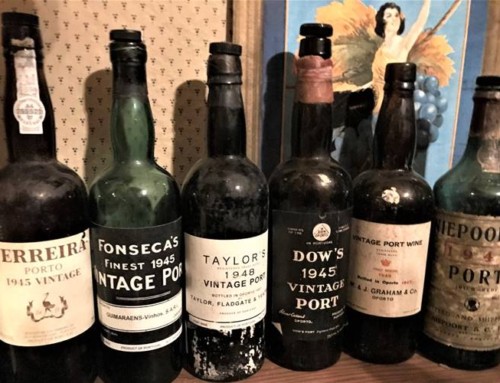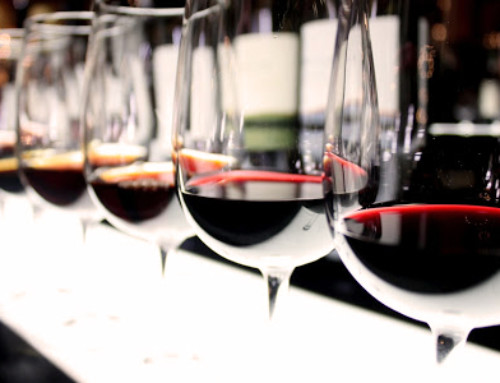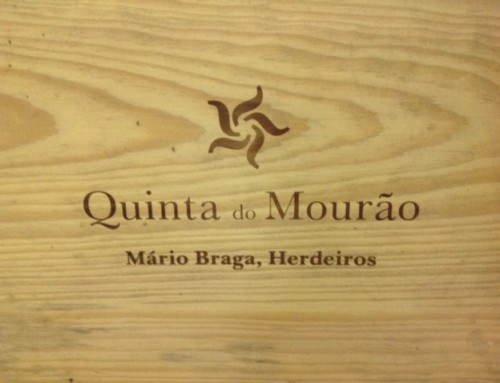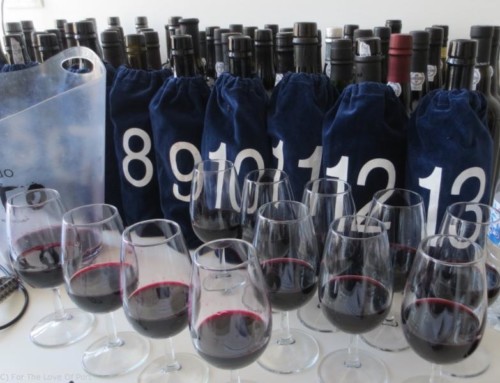Edmonton Alberta is one of my favorite cities in Canada, actually, in all of North America. Along with Vancouver, it’s a place that I visit every year, in order to see friends and get involved in their vibrant wine and food culture. While Vancouver is far more glitzy and trend conscious, it has a fast-paced heartbeat and vivacious nightlife. Edmonton is just the opposite; life is far less harried and it’s a great place to relax and smell the roses, or the wine in your glass. Its downtown area is rather sedate by comparison, yet it is modern and thriving too.
Over the past eight years, I’ve gone to Edmonton every November to hang out with my good friend Richard Beeken and his wonderful family. The timing of my trip always coincides with his birthday weekend and he organizes several celebratory wine events over those three days. Richard is a serious oenophile, truly enjoys great Port and in recent years has grown an affinity for aged Madeira.
In the early years of our friendship he introduced me to the folks who own and operate one of the finest wine shops in Edmonton. Since they opened shop in February 2005, I’ve become friends with three of the four owners, (I’ve never met the 4th partner). It is an extremely well appointed wine shop, deVine Wines & Spirits, and the proprietors are serious wine aficionados and educators, with well-trained palates and diverse areas of expertise.
Fortunately for me, they all love Port and Portuguese wines and one of the owners is originally from Portugal, which explains why deVine’s possesses the most comprehensive selection of Portuguese wines I’ve ever seen at retail; outside of the motherland. Each year, my Edmonton vacation includes hosting a seminar for deVine’s clientele on the night of my arrival. The Port-centric theme changes as does the venue, and this year was no exception. At the end of the tasting-seminar, a large group of friends goes out to a fabulous pizza place and we bring a wide array of wines to try. I always find this entertaining and actually funny, as typically Port is consumed at the end of the night, and here, we have dinner after we’ve consumed all of the Ports. If only the rest of the world drank that way!
This year we decided to offer a completely different look at Port by including eight unique bottles of Colheita. It was in fact, the very first time deVine’s has had any Colheitas as part of our Port lineup, as Vintage Ports have always been the center of attention; whether themed by producer, or featuring a horizontal or vertical tasting. That has likely been due to the shop’s wonderful selection of Vintage Ports and until this tasting, Colheita was never a big Port player in the Province of Alberta. Given the feedback and sales from this particular event, that may be something that changes a bit, in the future.
It is easy to remember the date of deVine’s recent event, as it was held on 11/11/11, which doesn’t happen often. We arrived at the members-only Royal Glenora Club, in the heart of Edmonton’s river valley and the banquet room was all set up and ready for the tasting. It is gratifying that each year it seems that I notice more and more repeat clients coming out for the Port seminar. I enjoy this every bit as much as they do, in part because I am allowed to participate in coming up with an intriguing theme, and also due to the fact that the guests are so into learning about Port and ask extremely detailed questions. They are literally thirsty for obtaining as much knowledge about Port as possible.
We had a total of seven Colheita Ports which deVine’s discounted for sale just for the attendees, at the end of the night. It is always great to be able to taste the wines and select which ones meet your palate’s sweet spot before making a buying decision, so this is a great way for wine shops to not only sell wine, but to educate their customers. As I like to do, I brought an additional “mystery bottle” which I knew was not available in North America and felt it would fit in nicely with the theme. Therefore, of the eight bottles at the tasting, we had five different producers represented overall. The Ports were all served non-blind.
Some of the key points that were touched upon that seemed important for explaining Colheita Ports:
- Explanation of what a Colheita is and the IVDP regulations for vintage dated Tawny Port.
- What makes Colheita such a unique category and the distinction between it and Tawny Port.
- The use of old neutral oak toneis or balseiros to increase the surface area of Port : wood which results in having a greater effect on the polymerization of polyphenols, producing Tawny colors and flavors (of course this was simplified and explained in far greater detail in person).
- The evaporation of Port in wood and the difference between “topping off” vs “refreshing”.
- The oxidative nature of Colheita and advantages, such as extended shelf life and the value for money in relationship to Vintage Port, plus the ease of serving.
- The production and aging of Colheita, including various racking regimens used by producers.
- Why the actual year of the harvest is less important with a Colheita than a Vintage Port.
- The theories and empirical evidence of wood vs. bottle aging of vintage dated Tawny Port.
- Cellar aging, proper serving temperatures and suggestions for food accompaniments.
Those were the basics discussed in detail, but throughout the tasting there were many fine questions, some particularly advanced for an introduction to a new category. I find the Edmonton wine crowd extraordinarily well versed in wine in general and not surprisingly, in Port in particular. It seems deVine’s has done an outstanding job of bringing in a variety of members from the Port trade to their shop and having the managers and owners all so well versed on Port also helps to increase the knowledge base of their customers. One just needs to look around their wine shop and see the large quantities of Port that is available there, (not to mention other Portuguese DOC non-fortified wines) to know that they take the Port category seriously. From what the owners have told me, they sell a lot of it there. I am not sure if it is due to very long, snowy and frigid winters in Edmonton; or the great job done by deVine’s management, but I suspect it’s a definite combination of both dynamics.
Now onto the Colheitas we tasted that evening:
1999 Barão de Vilar Colheita Port – Bottled in 2010. A little known producer, virtually invisible in the USA; this shipper was established in 1715 by members of the Kopke and van Zeller families. Medium ruby in color with significant bricking on a narrow meniscus. Gentle fragrances of leather, orange blossom, toffee, and a wisp of spirit. There is very little in the way of wood-aged evolution in this Colheita, and it remains too much like a Ruby Port. As it sat in the glass over the course of the evening, it gained a slight bit of heft and was medium-bodied and nicely balanced. If it had been served blind, I’d never have detected that it was a Colheita and therein lies a fairly significant issue for me. Nonetheless, it tasted good, with flavors of raspberry, mocha and a spicy medium-length finish. Although wood-aged for eleven years, this clearly wasn’t long enough. The selling price = $54.99 CDN. 84 points 11/11/11
1988 Kopke Colheita Port – Bottled 2009. For centuries Kopke held the claim of being the very first Port shipper, having been established in 1638; owned for the past half decade by Sogevinus. Garnet centered hue with amber-orange outer crescent. Provocative aromas of walnut, strawberry, caramel, a distinctive vanilla bean essence, roasted nuts and an exotic Asian spice scent to round out the profile. It’s mouth filling with lots of glycerin, and a soft, smooth texture. Upon entry, this 1988 is slightly warming and provides an illusion of having more developed flavors than its age would suggest which is a fine quality to possess. The mid-palate is somewhat simple in terms of its depth, but future bottlings will allow for more wood-aging, and would surely cure that. I really enjoyed the long and citrus laden and hazelnut finish. The selling price = $31.99 CDN/375 ml. 89 points 11/11/11
1985 Messias Colheita Port – Bottled 2010. The Messias firm was established in 1926 but did not begin selling Port for another eight years. Most Messias grapes come from Quinta do Cachão. Messias produces wine in seven distinct regions throughout Portugal and is sold on five continents. I’ve had a few types of Messias Ports in the past, but never one of their Colheitas. Medium orange-amber color with a golden rim. Harmonious smoky scents of old mahogany, nut skin, and distinctive Terry’s orange milk chocolates. Admittedly taken aback by the elegance of this Port, it is viscous and rich, delivering a decadent silky sumptuous palate impression and although there’s some warmth in the mid-section, it is layered with flavors of sultana, figs, a hint of spice, mocha and the fine finish was exceptionally long. With 25 years of wood aging already, ten to fifteen more years would enable this to reach a truly profound level; it’s that good. The selling price = $87.00 CDN. 91 points 11/11/11
1982 Messias Colheita Port – Bottled 2008. Brownish-tawny color with glints of ruby and a clear rim. Austere initially, the reticent aromatics took several hours to emerge and finally showed some cinnamon and leather notes, along with golden raisin and very mild VA which added intricacy to the nose. Light-medium-bodied, soft and exotic, rich and spirituous, the flavors were primarily toasted almond and walnut driven with just a modicum of dried apricot which kept the ‘82 from appearing too dry. There’s a bit of heat and loads of mouthwatering acidity, but the finish was a bit clipped. A nice Colheita overall, but lacked the “wow factor”. The selling price = $87.00 CDN. 86 points 11/11/11
1975 Barros Colheita Port – Bottled 2007. Founded in 1913 by Manoel de Almeida, it has been owned by the Spanish group, Sogevinus since the purchase from the Barros family in 2006. This Port stood out above the others that came before it. Medium-dark maple optic with a golden-amber meniscus. The Barros presents captivating scents of coconut, ripe apricot and pralines followed by a sensational whiff of crème brûlée, evoking an exhilarating ethereal essence. Medium weight and ultimately approachable from the get go, this is a sublime Colheita with ample acidity and an orange vs. grapefruit interplay and torched brown sugar flavor profile, won me over. The velvet-like texture and rich viscosity of this 1975 Colheita was made all the more enjoyable by sweet, smooth, liquefied butterscotch on the exotic lengthy finish. The selling price = $110.00 CDN. 92 points 11/11/11
1967 Barros Colheita Port – Bottled 2007. Following the 1975 Barros was no easy feat, but the 1967 was up to the challenge and exceeded expectations. Absolutely lovely as it evolved in the glass over several hours, the multifaceted nose presented spicy cinnamon notes, walnuts, a roasted scent and over-ripe nectarine. Concentrated and unctuous, this sublime Barros is one of the better Colheitas I’ve had from this Port house. Full-bodied and decadent with mink-like textural pleasure the flavors are nut driven with pecan and marzipan along with tart tangerine and peach. The razor sharp acidity added pizzazz to the great depth of flavors, followed by a profound finish which lingered for minutes. The selling price = $169.00 CDN. All I can say at this point is “wow”! 94 points 11/11/11
1966 Messias Colheita Port – Bottled 2010. Mr. Messias Baptista was the Chairman of the company from its founding in 1926 up until 1973. Medium amber color with a greenish tinge on the rim. Seductive and understated scents of mandarin orange, wood smoke, clove, vanilla extract and candied hazelnuts deliver a memorable bouquet. There’s a bit of a hot streak that blew off about two hours after it was poured and the intensity played out in the mid-palate with flavors of maple, toffee, brown sugar and tart grapefruit, providing balance to the sweetness. This 1966 is a stylish well-aged Colheita that shows class and symmetry, supported by lip smacking citric acidity and a hedonistic mouthfeel. A standout best bottle of Messias Port I’ve ever tasted. The selling price = $110.00 CDN. 93 points 11/11/11
1967 Dalva “Rui Paula” Colheita Port – Bottled 2009. Chef Rui Paula is the most renowned chef/owner in Northern Portugal, (with DOC & DOP restaurants in the Douro and Porto, respectively). Rui decided to work with Dalva to create a Colheita blend for his restaurants, from his birth year. I’ve been fortunate to purchase about fifteen of the 500 bottles from this limited, numbered and signed edition. Every single bottle I’ve opened so far has been shared with a group of Port lovers. When deciding which Colheita to bring to Edmonton to end the night’s event with a bang, the ’67 Dalva was the obvious choice. This was served after the seven deVine bottlings and although I am biased, it stood apart from all of the others. The intensity of the bouquet was flagrant and fragrant with spiced cinnamon, ripe fig, key lime and Frangelico; and after it opened even more, I also smelled sweet ripe peach. Richly textured and powerful on the palate with piercing acidity and sweet apricots, quince, Marcona almond brittle and Satsuma orange flavors. As expressive as is the aromatics and palate of this Port, the characteristic that stands out the most was the absolutely sublime lemony-caramel finish which glides across the palate like poetry in a glass. This is a classic Colheita whose scarcity makes it all the more special. I was thrilled to be able to share it with this fine group of Canadian Port lovers! 95 points 11/11/11
My sincere thanks to the deVine owners who set up this excellent event: Dirk Chan and Annabelle Evaristo and also Richard Beeken and family, for their many years of friendship and generosity, without which I would never have experienced the greatness of Edmonton in the first place.






Leave A Comment
You must be logged in to post a comment.